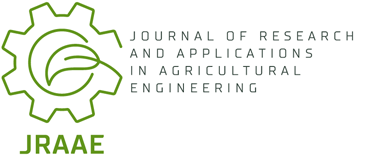Current issue
Online First
Archive
Instructions for Authors
Guide for Authors
Peer Review Policy
Research Ethics Policy
Ghostwriting and Guest Authorship
Copyright
Open Access Policy
Plagiarism
About the Journal
Aim and Scope
Scientific Board
Publisher
Editorial Board
Indexing in Databases
Personal Data Protection
Repository Policy
Contact
ORIGINAL PAPER
Determination of heat production in deep litter and in energy roof
Journal of Research and Applications in Agricultural Engineering 2006;51(1):5-9
KEYWORDS
ABSTRACT
Investigations of the installation for recovery and accumulation of heat generated in the animal building were executed. In the floor under the deep litter a tubular heat exchanger was placed, and on the roof placed was a set of solar collectors consisting of water panels integrated with the elements of the roof. Liquid from "energy roof" was directed to the boreholes where the heat was transferred to the ground deposit. The heat was used in winter season for warming up the production rooms, offices and bathroom. Comparison of heat amount coming from solar radiation with heat transferred to the liquid showed that energy roof prepared in Polish conditions reached the efficiency of 40%, what was 50-80% of performance achieved by original panels delivered by Dutch company R&R Systems b.v. Worse heat transfer was caused by poor quality of the glue used for joining. In the production room there was an effect of reduction of emissions of ammonia and greenhouse gases. The Netherlands experiments confirmed results of calculations by a special computer model. The COP (coefficient of performance) of the heat pump was a little lower than expected (3,2 versus 3,5).
REFERENCES (11)
1.
Aarnink, A. J. A., and P. Nijenhuis. 2004. Computer model 'pig heat and straw' v1.2 No. 2004. Agrotechnology and Food Innovations.
2.
Aarnink, A. J. A., M. J. M. Wagemans, and G. M. Nijeboer. 2004. Emissies uit een welzijnsvriendelijke stal voor vleesvarkens; het 'canadian bedding system'. Rapport 084, Agrotechnology and Food Innovations, Wageningen.
3.
Aarnink A.J.A., Myczko A., Karlowski J.: ,,Use of a heat pump for environmental and welfare friendly pig housing systems with straw, Exploratory Award".
4.
Aarnink, A.J.A. 1997. Ammonia emission from houses for growing pigs as affected by pen design, indoor climate and behaviour. Wageningen 1997. [in English]Anonymous. 2004. Handboek voor de varkenshouderij. Praktijkonderzoek Veehouderij, Animal Sciences Group, Lelystad. Anonymous. 2005. Wijziging regeling ammoniak en veehouderij Staatscourant. p 1-9.
5.
Den Haag. Block R. "Manure treatment outside the pig house. Options the for the biogas generation from straw". A report D5.1 for the project Pig Heat and Straw. Canh, T. 1998.
6.
Ammonia emission from excreta of growing-finishing pigs as affected by dietary composition. Wageningen 1998. [in English].
7.
Kuczyński, T. 2002. Emisja amoniaku z budynków inwentarskich a środowisko. Redakcja Wydawnictw Naukowo-Technicznych Zielona Góra 2002. [in polish].
8.
Myczko A., Nawrocki L., Karlowski J.: ,,The influence of the extracting and storing of heat energy cumulated in a building for animals on the value of harmful gases in a ventilated air", Szklarska Poreba, Institute for Building, Mechanization and Electrification of Agriculture, Branch Poznan. Monteny.
9.
G. J. C. M. G., and M. A. Hilhorst. 2001. Interactions and coupling between emissions of methane and nitrous oxide from animal husbandry. Nutrient Cycling in Agroecosystems 60: 123-Nawrocki L., Myczko A.: "The heat recovery from straw beddings on a pig farm", Probl. Inż. Rol, 1998, R. 6 No. 4(22), s. 125-130.
10.
Nawrocki L., Myczko A.. Kanikowski J.: ,,Pompa ciepła na głębokiej ściółce", (,,Heat pump on a deep bedding"), Trzoda Chlewna, 6/1999, p. 105-108.
11.
Van Ouwerkerk, E. N. J. 1999. Anipro: Klimaat- en energie-simulatiesoftware voor stallen. Nota V99-109, IMAG Wageningen.
Share
RELATED ARTICLE
We process personal data collected when visiting the website. The function of obtaining information about users and their behavior is carried out by voluntarily entered information in forms and saving cookies in end devices. Data, including cookies, are used to provide services, improve the user experience and to analyze the traffic in accordance with the Privacy policy. Data are also collected and processed by Google Analytics tool (more).
You can change cookies settings in your browser. Restricted use of cookies in the browser configuration may affect some functionalities of the website.
You can change cookies settings in your browser. Restricted use of cookies in the browser configuration may affect some functionalities of the website.


